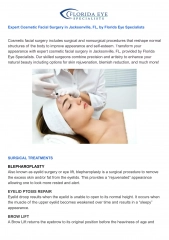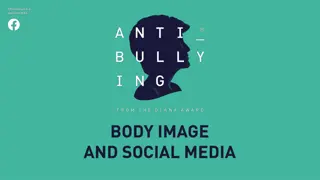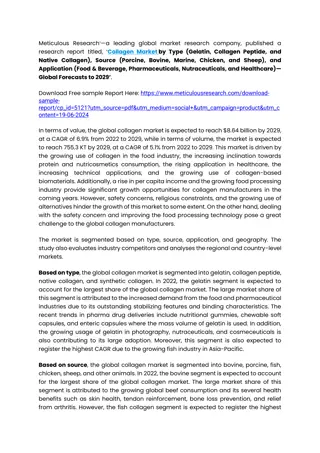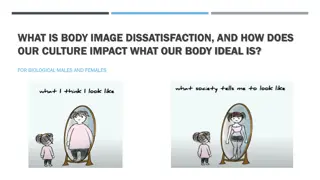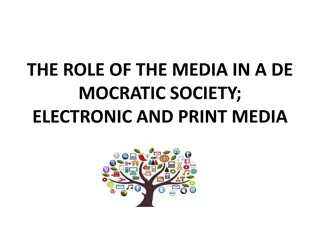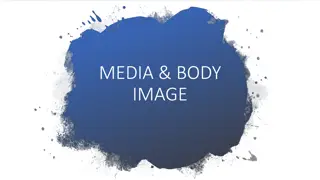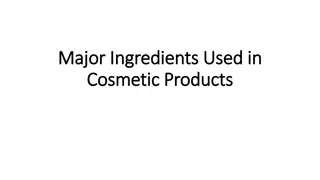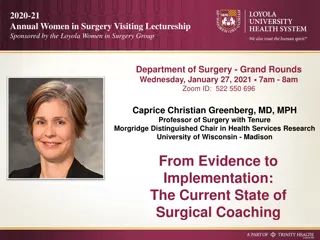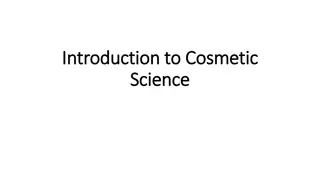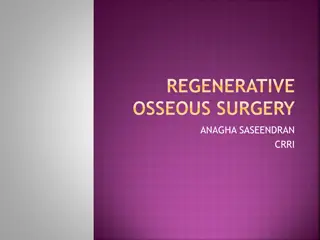Influence of Society and Media on Body Modification Through Cosmetic Surgery
The presentation explores how society and media influence body modification through cosmetic surgery, focusing on Foucauldian framework. It discusses the construction of docile bodies, objectification in media, the controlled body by societal norms, disciplined body through fear and expectations, and the normalization of cosmetic surgery driven by popular media discourses. Emphasis is placed on the commodification of the body and the impact of consumerist culture on cosmetic surgery trends.
Download Presentation

Please find below an Image/Link to download the presentation.
The content on the website is provided AS IS for your information and personal use only. It may not be sold, licensed, or shared on other websites without obtaining consent from the author.If you encounter any issues during the download, it is possible that the publisher has removed the file from their server.
You are allowed to download the files provided on this website for personal or commercial use, subject to the condition that they are used lawfully. All files are the property of their respective owners.
The content on the website is provided AS IS for your information and personal use only. It may not be sold, licensed, or shared on other websites without obtaining consent from the author.
E N D
Presentation Transcript
BODY MODIFICATION THROUGH COSMETIC SURGERY Society and Media s Influences SOSC 3930 / University and Society /
Presentation Agenda Part 1: Foucauldian Framework The Construction of Docile Bodies Thesis Independent and Dependent Variables Discourses in Popular Media The Attainment of Beauty and Perfection Minorities and Ethnic Cosmetic Surgery Personal Life Enhancement Medicalization of the Female Body The Body as a Commodity A Complete Transformation Overall Course Connections
Part 1: The Framework Foucault s Archaeology of Power: Construction of a Docile Body 1) Objectified Body: This is supported by the objectification theory, in which a person takes an external perspective of their physical appearance. (Fredrickson & Roberts, 1997) Self-objectifying individuals equate their identity and self-worth in terms of their body as an object to be looked at by others. (Fredrickson & Roberts, 1997) The media emphasizes isolated body parts such as buttocks, cleavage, stomach (Kolbe & Albanese, 1996), therefore conveying the message of the body as an important aspect of sexual desirability. (Aubrey, 2006) The objectified body learns to separate the mind from the body, thus supporting the concept of body parts as a commodity.
Part 1: The Framework Foucault s Archaeology of Power: Construction of a Docile Body 2) Controlled Body: Inscribing the self : The gaze controls and punishes (Keller, 2005) The normalizing gaze controls what people do and how they see themselves-- establishing a binary system (Normal vs. Abnormal) Normalization: Control mechanism causing individuals to be regulated by the disciplinary gaze of the dominant culture Body Surveillance: Women are bound by idealized images and consequently feel a desire to adhere to that standard. (Engeln-Maddox, 2005)
Part 1: The Framework Foucault s Archaeology of Power: Construction of a Docile Body 3) Disciplined Body: Techniques of Discipline: fear of becoming abnormal, fear of failing expectations Foucault s care of self drives people to work on self-improvement (docile bodies to be used, transformed, and improved) Patients willingly turns into a docile body through the disciplinary gaze of surgeons. (Martin, E. 1993)
Thesis The consumerist culture of cosmetic surgery can be attributed to goals of aspiration and emulation in which people are perceiving surgery to be more accessible, less invasive and normalized by society. These messages are shaped through popular media discourses. Media promotes the view that one can enhance their personal life through changing their outer appearance. The physical body is shown as a malleable object to be modified in order to match their outer appearance with their inner character. This is further amplified by the pressures to conform to idealized beauty norms as defined by media images. Although the media frequently discusses the implications involved, the general notion is that cosmetic surgery is risky but ultimately worthwhile.
Thesis Independent vs. Dependent Variables COSMETIC SURGERY POPULAR MEDIA DISCOURSES Removal of Social Stigma Attaining Beauty & Perfection Normalized Personal Life Enhancement Acceptable The Complete Transformation Desirable
Context of Analysis Cosmetic Surgery Defined: Refers to invasive surgical procedures (e.g. Breast implants, liposuction, facelift). Cosmetic surgery is done for aesthetic purposes where surgery is used to alter normal and physically healthy bodies. Source: Canadian Society for Aesthetic (Cosmetic) Plastic Surgery Focus on the Female Perspective: In 2003, over 302 000 surgical and nonsurgical cosmetic enhancement procedures were performed in Canada, 85.4% of which were performed on women. Source: Medicard Finance, 2005
Discourse #1: Attainment of Beauty & Perfection Course Kit Readings Even in instances where there is evidence of critical processing, it is clear that women are still bound by idealized images and consequently feel a desire to adhere to that standard. (Engeln-Maddox, 2005) The finding show that social comparison is associated with body dissatisfaction, as very few people are able to match the strict definitions of beauty as constructed by the media. (Engeln-Maddox, 2005) This is further explored by correlational studies in which a link has been established between idealized media images and body image disturbance. (Botta, 1999; Harrison & Cantor, 1997)
Discourse #1: Popular Media Christian: When you stop striving for perfection, you might as well be dead. http://www.youtube.com/watch?v=- EpMit9aXi4
Discourse #1: Popular Media I was never the prettiest girl I was more like the frumpy sidekick to Lauren I just love boobs. They make me feel more womanly. I plan to keep using surgery to make me as perfect as I can be...surgery is always so rewarding.
Discourse #1: Attainment of Beauty & Perfection Subtheme: Minorities and Ethnic Plastic Surgery Minorities are excluded from many popular media and are relegated to secondary roles. (Eschholz, Bufkin & Long, 2002), this promotes the view that individuals need to erase their ethnic traits in order to succeed in a white dominated society More than 1.3 million cosmetic plastic surgery procedures were performed on ethnic patients in 2004, an increase of 44% since 2000: 14% of all cosmetic plastic surgery patients in the US were Asian, black, or Hispanic. (Euromonitor, 2006)
Discourse #2: Personal Life Enhancement Individuals use the justification that cosmetic surgery will enhance functioning, health and size. (Heyes, 2007) Representations show cosmetic surgery as a liberating experience where an individual is given the power to take control on their life (Davis, 2002) Approximately one third of cosmetic surgery articles featured in popular women s magazines between 1980 and 1995 feature explicit claims of positive mental health benefits in addition to physical changes. (Sullivan, 2001) Belief that by conforming to beauty norms, one will be able to achieve greater success and happiness
Discourse #2: Popular Media http://www.youtube.com/watch?v=7NaVeO Hhl00
Discourse #2: Popular Media Moe Szyslak from the Simpsons is portrayed as a short tempered, suicidal, and unlucky bartender Frequently described as ugly, and has an almost nonexistent love life In Season 11, Moe undergoes plastic surgery which enables him to fulfil his dreams of becoming a soap star, and to attract the attentions of many women
Discourse #2: Personal Life Enhancement Subtheme: Medicalization of the Female Body The linkages between cosmetic surgery and enhanced emotional wellbeing relies upon a framework of medicalization seemingly nonmedical issues become defined as a problem in need of medical treatment Medical professionals are portrayed as experts on beauty (Polonijo, Carpiano, 2008) Professional opinions are frequently quoted in magazine articles (57%) in order to provide benefit and risk information, and reassure readers that cosmetic surgery can be a safe and beneficial choice. (Sullivan, 2001)
Subtheme: Medicalization of the Female Body Christian: When you stop striving for perfection, you might as well be dead. http://www.youtube.com/watch?v=- EpMit9aXi4
Discourse #3: The Complete Transformation Cosmetic surgery has led to a contemporary discourse in which one desires to match their physical appearance with their inner self. (Heyes, 2007) From the success of movies such as She s All That, to the circulation rates of People magazine, the idea of a fairy tale transformation is resonating deeply with audiences. (Brooks, 2004) Ignore the complexities associated with creating homogeneous bodies, but instead deploys allusions of fairy tales. (Heyes, 2007) The fairy tale metaphor is psychologically fulfilling as it emphasizes the turmoil and unhappiness before culminating in a happy ever after. (Heyes, 2007)
Discourse #3: Popular Media Cosmetic surgery makeover shows use before and after pictures use a narrative of a fairy tale transformation The objective of the show is to completely revolutionize the physical appearance of contestants through makeup, wardrobe, hair and intensive body modification through cosmetic surgery. 4.29
Discourse #3: Popular Media Soaps often feature plot lines involving characters undergoing plastic surgery to become exact look-alikes of other characters. Social Cognitive Theory posits that portions of an individual s knowledge acquisition can be related to observing others. (Russell, 2005) Gives an unrealistic view of the potential outcome of cosmetic surgery as a vehicle for transformation.
Discourse #3: Popular Media In January 2010, news outlets reported of a Chinese woman seeking cosmetic surgery to look like Jessica Alba
Discourse #3: The Complete Transformation Subtheme: The Body as a Commodity Body has been transformed into a component that can be reformed and sculpted to create a new and improved commodity to be purchased. (Bordo, Class Lecture) Objectification Theory: Based on the premise that women in particular are inclined to take on an external view of their physical selves which in turn promotes that view of measuring one s self worth in terms of the body. (Fredrickson & Roberts, 1997) There is a tendency for a focus to be put on isolated body parts such as the stomach, buttocks, cleavage, legs, (Sommers-Flanagan & Davis, 1993) which teaches individuals to view the physical body as a commodity.
Discourse #3: Popular Media Hollywood s Most Wanted Parts Lips Eyes Body Jawline
Conclusion Popular media is presenting cosmetic surgery as a normal practice for attaining beauty and perfection, personal life enhancement and achieving transformation By presenting women of average and above-average appearance pursuing surgical cosmetic enhancement, this impacts our perception of what is considered beautiful and how to conform to beauty norms Future research and greater public awareness is necessary to establish link between media images and decisions to undergo cosmetic surgery
Widescreen Test Pattern (16:9) Aspect Ratio Test (Should appear circular) 4x3 16x9


